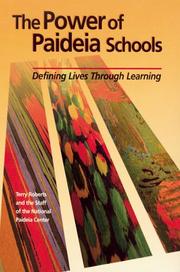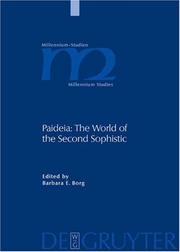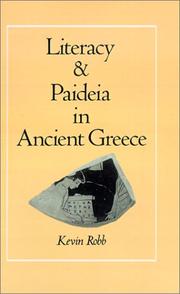| Listing 1 - 10 of 13 | << page >> |
Sort by
|
Book
ISBN: 9783110254051 3110254050 9783110254068 3110254069 9786613166708 1283166704 Year: 2011 Volume: 33 Publisher: Berlin ; New York : De Gruyter,
Abstract | Keywords | Export | Availability | Bookmark
 Loading...
Loading...Choose an application
- Reference Manager
- EndNote
- RefWorks (Direct export to RefWorks)
The work Eikones (Imagines/Images) by Philostratus consists of 64 fictitious descriptions of images. Mario Baumann analyzes the aesthetic virtuosity which characterizes this text. The speaker who formulates the descriptions proves himself a master in interpreting the images. He creates a unique textual composition of images which continually surprises and challenges the reader due to its diversity. The text of Eikones takes up the tradition of literature and at the same time changes it through the creation of new combinations, always revealing the virtuosity of the author.
Painting --- Mythology, Classical, in art. --- Early works to 1800. --- Philostratus, --- Eikones. --- Paideia. --- Philostratus.

ISBN: 1280928263 9786610928262 0871205491 1416605010 1416605029 9781416605010 0871203030 9780871203038 9780871205490 9781280928260 9781416605027 6610928266 Year: 1998 Publisher: Alexandria, Va. : Association for Supervision and Curriculum Development,
Abstract | Keywords | Export | Availability | Bookmark
 Loading...
Loading...Choose an application
- Reference Manager
- EndNote
- RefWorks (Direct export to RefWorks)
Beginning in 1982 philosopher Mortimer Adler led a group of educators and scholars in publishing a trilogy of books on what they called ""Paideia"" educational reform. The first book, The Paideia Proposal, had a profound effect on most of the major reform efforts that followed, and Paideia principles--including the then radical notion that ""all children can learn""--eventually permeated the educational dialogue. Merging the conservative idea of a classical education with progressive ideas about teaching and learning, Paideia educators strive to provide all children with a rigorous and meaning
School improvement programs --- Basic education --- Education, Humanistic --- Curriculum change --- National Paideia Center.
Book
ISBN: 9789042940048 9042940042 9789042940055 Year: 2020 Publisher: Leuven : Peeters ;
Abstract | Keywords | Export | Availability | Bookmark
 Loading...
Loading...Choose an application
- Reference Manager
- EndNote
- RefWorks (Direct export to RefWorks)
In the ancient Graeco-Roman East different types of interaction between Greek and local cultures took place. The present book investigates them from different viewpoints in their different manifestations (education, language, literature, etc.), and in different geographical areas: Egypt, Syria, Pontus Cappadocia, Propontis, Bithynia, Phrygia, Pisidia or the whole of Asia Minor.0Did the Greek paideia intermingle with local traditions in the education of the local ruling classes? Did that have an impact on their prestige? Did this affect social classes? What were the extent and consequences of the linguistic contact between Greek and the local languages? Where there phenomena of Greek-local cultural translations or adaptations? What was the degree of penetration of the Greek literary models or topoi? How was the interaction of Greek paideia and the ancestral (local or regional) religions? What was the role of the Greek paideia as a signpost of identity? How did Greek and Latin coexist in this context?0To answer such questions, the different papers in the current volume study each of them from a particular point of view, paying attention to the evidence available.
Byzantine Empire --- Greek influences. --- Civilization, Classical. --- Education, Greek. --- Education --- Language and culture --- History. --- Greece --- Middle East --- Civilization. --- Griechen. --- Kulturvermittlung. --- Paideía (le mot grec). --- paideia. --- Örtliche Elite. --- Lang, Johann Gottfried, --- Empire byzantin --- Hellenistische Staaten. --- Influence grecque. --- Civilization [Greco-Roman ] --- History --- World history
Book
ISBN: 3110431343 3110431491 9783110431490 9783110431346 3110431351 3110439042 Year: 2015 Publisher: Berlin Boston
Abstract | Keywords | Export | Availability | Bookmark
 Loading...
Loading...Choose an application
- Reference Manager
- EndNote
- RefWorks (Direct export to RefWorks)
The Letter of Aristeas has been an object modern scholarly interest since the seventeenth century. It is best known for containing the earliest version of the translation of the Hebrew Law into Greek, and this story accounts for much of the scholarly attention paid to the work. Yet, this legend only takes up a small percentage of the work. Looking at Aristeas as a whole, the work reveals an author who has acquired a Greek education and employs both Jewish and Greek sources in his work, and he has produced a Greek book. Even though Aristeas has garnered scholarly attention, no fully fledged commentary has been written on it. The works of R. Tramontano, M. Hadas and others, often referred to as commentaries, only contain text and annotated notes. This volume fills the gap in the scholarship on Aristeas by providing a full, paragraph-by-paragraph commentary, containing a new translation, text-critical notes, general commentary, and notes on specific words, phrases and ideas.
Jews --- Judaism --- Aristeas. --- Hellenistic Judaism. --- Hellenistisches Judentum. --- Jewish paideia. --- Paideia. --- Septuagint. --- Septuaginta. --- RELIGION / Judaism / History. --- Hellenistic Judaism --- Judaism, Hellenistic --- Civilization --- Greek influences. --- History --- Letter of Aristeas --- Aristeas' epistle --- Aristeas' letter --- Aristeas to Philocrates --- Aristeae Historia LXXII interpretum --- Historia LXXII interpretum --- Aristeae Ad Philocratem epistula --- Ad Philocratem epistula --- Aristeasbrief --- Criticism, interpretation, etc.
Book
ISBN: 9783110563559 9783110562613 9783110530469 3110530465 311056355X 3110562618 Year: 2018 Publisher: Berlin : Walter de Gruyter,
Abstract | Keywords | Export | Availability | Bookmark
 Loading...
Loading...Choose an application
- Reference Manager
- EndNote
- RefWorks (Direct export to RefWorks)
In recent years, scholars have extensively explored the function of the miraculous and wondrous in ancient narratives, mostly pondering on how ancient authors view wondrous accounts, i.e. the treatment of the descriptions of wondrous occurrences as true events or their use. More precisely, these narratives investigate whether the wondrous pursues a display of erudition or merely provides stylistic variety; sometimes, such narratives even represent the wish of the author to grant a ?rational explanation? to extraordinary actions. At present, however, two aspects of the topic have not been fully examined: a) the ability of the wondrous/miraculous to set cognitive mechanisms in motion and b) the power of the wondrous/miraculous to contribute to the construction of an authorial identity (that of kings, gods, or narrators). To this extent, the volume approaches miracles and wonders as counter intuitive phenomena, beyond cognitive grasp, which challenge the authenticity of human experience and knowledge and push forward the frontiers of intellectual and aesthetic experience. Some of the articles of the volume examine miracles on the basis of bewilderment that could lead to new factual knowledge; the supernatural is here registered as something natural (although strange); the rest of the articles treat miracles as an endpoint, where human knowledge stops and the unknown divine begins (here the supernatural is confirmed). Thence, questions like whether the experience of a miracle or wonder as a counter intuitive phenomenon could be part of long-term memory, i.e. if miracles could be transformed into solid knowledge and what mental functions are encompassed in this process, are central in the discussion.
E-books --- Antiquités. --- Appréciation. --- Miracles --- Miracles. --- Paradoxe. --- Étonnement --- Miracles in literature. --- Classical literature --- History and criticism. --- Supernatural in literature. --- Miracles in literature --- Supernatural in literature --- Themes, motives --- Themes, motives. --- Commemoration. --- paideia. --- religion. --- science.
Book
ISBN: 3110548100 3110548984 9783110548983 9783110548105 9783110548037 3110548038 9783110548990 3110548992 Year: 2017 Publisher: Berlin Boston
Abstract | Keywords | Export | Availability | Bookmark
 Loading...
Loading...Choose an application
- Reference Manager
- EndNote
- RefWorks (Direct export to RefWorks)
Die Arbeiten von Werner Jaeger haben vor etwa hundert Jahren das Studium der Antike prägend und international beeinflusst, insbesondere im Bereich der Geschichte der antiken Wissenschaft und Philosophie, doch bleibt die Figur Jaegers umstritten. Er steht am Ende einer Glanzzeit der Philologie an der Berliner Universität und erlangte früh internationale Anerkennung sowie enormen Einfluss. Sowohl sein wissenschaftliches Werk als auch seine Paideia wurden stark rezipiert, letztere sogar in viele Sprachen übersetzt. In bemerkenswertem Gegensatz zu diesem frühen Glanz stehen die späteren Jahre seines Schaffens, in denen er trotz prominenter Stellung an der Harvard University nur relativ schwach nachwirkte. Das Ziel ist, zu differenzierten Urteilen über die durchaus gemischte Bilanz von Jaegers Werk und Wirken zu kommen. Seine wissenschafts- und philosophiehistorischen Leistungen sowie sein Agieren im bildungspolitischen Kontext seiner Zeit werden eingeordnet und kritisch untersucht. This book contains contributions by several different leading scholars on the foundational work of Werner Jaeger (1888–1961) for the study of the history of ancient philosophy, science, and religion. It also includes a critical reappraisal of Jaeger's role as a public intellectual in the 1930s.
Science --- Research --- Science research --- Scientific research --- Information services --- Learning and scholarship --- Methodology --- Research teams --- Science education --- Scientific education --- Study and teaching --- E-books --- Research. --- Study and teaching. --- Jaeger, Werner, --- Jaeger, W. --- Jaeger, Werner Wilhelm, --- Jaeger, Wernerus, --- Jäger. --- Paideia. --- classics.
Book

ISBN: 2713226058 2713222273 Year: 2017 Publisher: Paris : Éditions de l’École des hautes études en sciences sociales,
Abstract | Keywords | Export | Availability | Bookmark
 Loading...
Loading...Choose an application
- Reference Manager
- EndNote
- RefWorks (Direct export to RefWorks)
Dossier : Quel rapport l’image entretient-elle avec le support qui la véhicule ? Les vases attiques fournissent une quantité de représentations souvent traitées comme si elles étaient plates et immatérielles. Ce dossier questionne cette matérialité selon deux axes : comment l’image s’adapte-t-elle aux surfaces rondes, sphériques, circulaires du vase ? Varia : Paradigmes masculins (le vieux Priam, le héros euripidéen, sophistes platoniciens, Hermès au gymnase, Ésope). Archéologie d'un mythe (les Arimaspes). Étiologie. Conférence Gernet : Aube de la cité, aube des images ?
Art --- History & Archaeology --- Greek ceramics --- iconography --- judgment of Paris --- symposion --- phiale --- Priam --- Aesop Romance --- paideia --- sophists --- trade networks --- onomastics --- images --- iconographie --- iconographie des vases --- céramique grecque --- composition de l’image --- jugement de Pâris --- Roman d’Ésope --- sophistes --- étiologie --- réseaux de commerce --- Mer Noire --- onomastique

ISBN: 3110182319 9786613396822 311916495X 1283396823 3110204711 9783110182316 9783110204711 Year: 2004 Volume: 2 Publisher: Berlin ; New York : Walter de Gruyter,
Abstract | Keywords | Export | Availability | Bookmark
 Loading...
Loading...Choose an application
- Reference Manager
- EndNote
- RefWorks (Direct export to RefWorks)
In the World of the Second Sophistic, education, paideia, was a crucial factor in the discourse of power. Knowledge in the fields of medicine, history, philosophy, and poetry joined with rhetorical brilliance and a presentable manner became the outward appearance of the elite of the Eastern Roman Empire. This outward appearance guaranteed a high social status as well as political and economical power for the individual and major advantages for their hometowns in interpolis competition. Since paideia was related particularly to Classical Greek antiquity, it was, at the same time, fundamental to the new self-confidence of the Greek East. This book presents, for the first time, studies from a broad range of disciplines on various fields of life and on different media, in which this ideology became manifest. These contributions show that the Sophists and their texts were only the most prominent exponents of a system of thoughts and values structuring the life of the elite in general.
Education [Ancient ] --- Enseignement de l'antiquité --- Onderwijs van de oudheid --- Sofisten (Griekse filosofie) --- Sophistes (Philosophie grecque) --- Civilization, Greco-Roman --- Sophists (Greek philosophy) --- Philosophy, Ancient --- Civilisation gréco-romaine --- Sophistes grecs --- Congresses --- Congrès --- Rome --- History --- Histoire --- Second Sophistic --- Roman Empire --- Classical age --- education --- paideia --- knowledge

ISBN: 1280760141 0195363167 9780195363166 0195059050 9780195059052 0197704778 Year: 1994 Publisher: New York Oxford University Press
Abstract | Keywords | Export | Availability | Bookmark
 Loading...
Loading...Choose an application
- Reference Manager
- EndNote
- RefWorks (Direct export to RefWorks)
This study traces the progress of literacy in Ancient Greece from its origins in the 8th century BC to the 4th century BC, when the major cultural institutions of Athens became totally dependent on alphabetic literacy.
Education --- Greek language --- Literacy --- Illiteracy --- General education --- Classical languages --- Indo-European languages --- Classical philology --- Greek philology --- Social aspects --- Alfabetisme. --- Alphabet. --- Bildungswesen. --- Education. --- Educação (aspectos sociais) --- Enfants --- Erziehung. --- Grec (langue) --- Griechisch. --- Griekse oudheid. --- Grèce --- Lesen. --- Letterkunde. --- Literacy. --- Literatur. --- Paideia. --- Schreiben. --- Schriftlichkeit. --- Éducation --- Dans la littérature. --- Aspect social --- Social aspects. --- Civilisation. --- Greece. --- Griechenland
Book

ISBN: 3110546116 3110546973 9783110546972 9783110546118 9783110547009 3110547007 9783110546064 311054606X Year: 2017 Volume: 228 Publisher: Berlin Boston
Abstract | Keywords | Export | Availability | Bookmark
 Loading...
Loading...Choose an application
- Reference Manager
- EndNote
- RefWorks (Direct export to RefWorks)
Despite the impressive strides made in the past century in the understanding of Second Temple Jewish history and the strong scholarly interest in paideia within ancient Greek, Hellenistic, Roman, and late antique Christian cultures, the nature of Jewish paideia during the period has, until recently, received surprisingly little attention. The essays collected here were first offered for discussion at the Fifth Enoch Seminar Nangeroni Meeting, held in Naples, Italy, from June 30 – July 4, 2015, the purpose of which was to gain greater insight into the diversity of views of Jewish education during the period, both in Judea and Diaspora communities, by viewing them in light of their contemporary Greco-Roman backgrounds and Ancient Near Eastern influences. Together, they represent the broad array of approaches and specialties required to comprehend this complex and multi-faceted subject, and they demonstrate the fundamental importance of the topic for a fuller understanding of the period. The volume will be of particular interest to students and scholars of the history and culture of the Jewish people during the Hellenistic and Roman periods, ancient education, and Greek and Roman history.
Judaism --- Jewish religious education --- Education, Jewish --- Jews --- Religious education, Jewish --- Moral education --- Religious education --- History --- History. --- Education --- Study and teaching --- Education, Ancient --- 296 <63> --- Hebrews --- Israelites --- Jewish people --- Jewry --- Judaic people --- Judaists --- Ethnology --- Religious adherents --- Semites --- Hellenistic Judaism --- Judaism, Hellenistic --- 296 <63> Judaisme--Ethiopië --- 296 <63> Judaïsme. Jodendom--Ethiopië --- Judaisme--Ethiopië --- Judaïsme. Jodendom--Ethiopië --- Civilization --- Greek influences --- Ancient Education. --- Greek Paideia. --- Jewish Identity. --- Second Temple Judaism.
| Listing 1 - 10 of 13 | << page >> |
Sort by
|

 Search
Search Feedback
Feedback About UniCat
About UniCat  Help
Help News
News